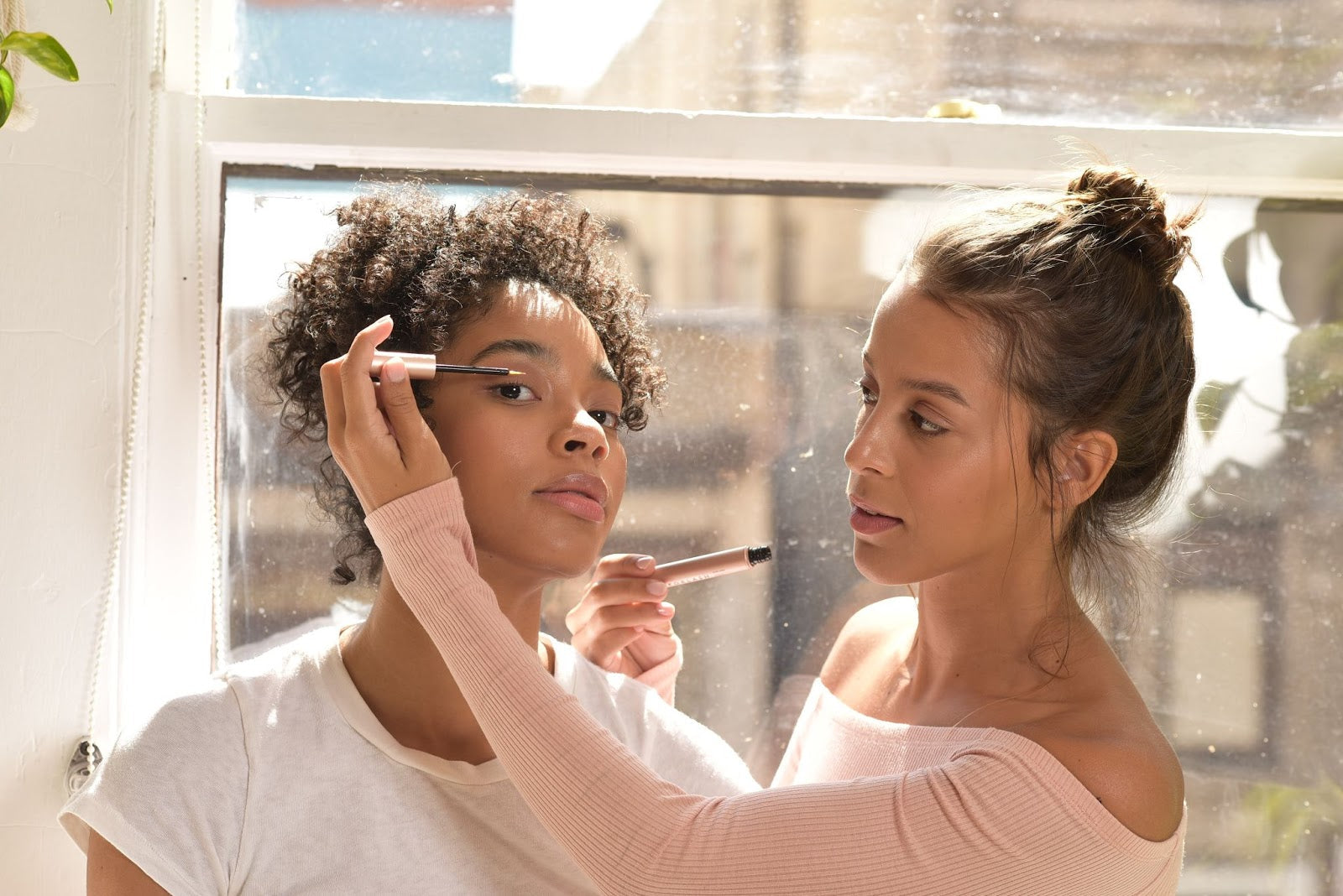Vegan beauty has its tab on most major beauty sites. More and more vegan beauty companies are cropping up. Established companies are creating lines of vegan products or even transitioning over into being vegan. Even if vegan beauty isn’t something you’ve gotten into -- it should be on your radar!
Maybe you’re hip to what’s vegan in the kitchen and have even experimented with some DIY vegan beauty experiments in your own home. But what’s stopping you from turning your skincare and beauty routine fully vegan?
Unlike food items, making sure a beauty product is vegan can be more difficult. Beauty products are made up of different ingredients, sometimes with confusing names and numbers, and any of those ingredients could be animal products with a code name.
We are here to break down what it means for a beauty product to be vegan, how to find those products, and what ingredients to watch out for.
What is Vegan Makeup?

Vegan makeup or vegan beauty products are cosmetics that do not contain any trace of animal ingredients, animal by-products, or ingredients derived from animals. Beeswax, honey, egg whites, and milk included.
How can you identify vegan makeup? It is usually labeled ‘vegan,’ ‘vegan-friendly,’ or ‘100% vegan.’ However, these phrases alone don’t certify that a product is truly vegan. To really know, you will have to check the ingredients thoroughly.
Is there a difference between ‘vegan’ and ‘vegetarian’ makeup? Yes!
Vegetarian makeup does not use ingredients that were a part of an animal, but they might use animal-made substances, such as beeswax, honey, snail slime, egg whites, and milk.
What is the difference between a vegan brand and a vegan product? Vegan brands have committed to being entirely vegan with every single product they make. Other brands are not fully vegan-friendly, but they do have some completely vegan products.
It’s important to note that “vegan” is not the same as “cruelty-free.”
Cruelty-free means the product was not tested on animals. Just because something is vegan does not mean it’s cruelty-free, and just because something is cruelty-free does not mean it is vegan!
Is vegan the same as clean, organic, non-toxic, natural, or fair trade? No. These are all different things. These buzzy labels are unregulated, and brands can write them on their products while having different definitions of what they mean.
While not regulated, there is a bit more structure with products being labeled vegan. In the past decade, trusted organizations have started creating certification programs to properly identify vegan products.
What Makes Vegan Products Vegan?

How can you be sure you are using a vegan product? Just because a product has a claim like “vegan” or “no animal ingredients'' written on it doesn’t mean it's true. There is a lack of federal regulation or standard on what these claims mean. Due to this, a handful of established organizations have created their own certification programs for vegan products.
If you want to be sure the products you are buying are vegan, lookout for some of these popular certification logos. Each of these organizations has different standards, ways of certifying, costs for authenticating, and different regions of regulation.
Beauty Without Bunnies

Beauty Without Bunnies is a certification program by PETA. PETA, which stands for People for the Ethical Treatment of Animals, is the world’s largest animal rights non-profit organization.
A Beauty Without Bunnies certification means a company has signed a legally binding pledge that their products are completely vegan and free of animal testing. PETA also has a separate pledge and logo for companies that are cruelty-free but maybe not vegan.
PETA has an app and website where you can search any company or product to check on their vegan and cruelty-free status.
Certified Vegan

Certified Vegan is a certification program by Vegan Action. Vegan Action is a non-profit organization that aims to eliminate animal suffering, reduce environmental impacts, and improve human health through a vegan diet.
Vegan.com was created in 1995 and is one of the world’s oldest and most visited websites.
Vegan Action’s program certifies a product is both vegan and cruelty-free. For a product to be certified, the company must submit documentation on each ingredient to prove it is not animal-derived and not animal-tested.
At the time being, Vegan Action only certifies individual products, not entire companies. The exception to this being approval of multiple brands for a single parent company.
Vegan Trademark

Vegan Trademark is a certification program by The Vegan Society. The Vegan Society is an educational charity based in Great Britain and is the oldest vegan organization in the world, founded in 1944.
The Vegan Society’s program certifies that a product is both vegan and cruelty-free. It also certifies that GMOs are labeled as such. The Vegan Society does not certify whole companies.
You can search for products with the Vegan Trademark through The Vegan Society’s website.
Leaping Bunny Program -- Not Vegan

Beware, a Leaping Bunny certification does not mean the product is vegan. Leaping Bunny certification is only for cruelty-free certification.
We wanted to include this one because the Leaping Bunny Program has been around since 1996, and the logo is internationally recognized. The Coalition of Consumer Information operates the Leaping Bunny Program on Cosmetics in the US and Canada (CCIC).
CCIC is a coalition of eight national animal protection groups.
It’s important to recognize that all of these certification programs require money to certify a product. It is also common for them to require an application fee and yearly recertification, which also costs a fee.
The best thing you can do is check out the ingredient list, and when in doubt, reach out to a company’s customer service to make sure.
Commonly Used Animal Ingredients

One way to make sure your products are truly 100% vegan is to get familiar with some of the most often used animal-derived products in makeup and beauty products. This list is just a starter, but you can check out PETA’s more comprehensive list if you want to buff up on your animal ingredients.
Beeswax
Beeswax, also known as cera alba, is a substance secreted by bees to construct their honeycombs. The beeswax is harvested by melting down the honeycombs. Beeswax is used as a soothing ingredient and a protective barrier.
Vegan alternatives to beeswax are paraffin, vegetable oils and fats, and ceresin.
Honey
Honey is the food bees make from their nectar collection. It is harvested by dismantling and draining the honeycomb. Honey is used as a soothing agent, a colorizer, and for the retainment of moisture.
Vegan alternatives to honey are vegetable colors and oils.
Carmine
Carmine is a red dye that is derived from pulverizing the bodies of cochineal insects. Carmine can be hard to find in ingredient lists as it goes by a few different names and some of those are just a combination of letters and numbers (CI 74570, E120, Red 4).
Vegan alternatives to carmine are beet juice and alkanet root.
Lanolin
Lanolin is a product of the oil glands of sheep. It is extracted from sheep’s wool. Lanolin is used as a moisturizing agent.
Vegan alternatives to lanolin are plant oils and vegetable oils.
Keratin
Keratin is used as a skin and hair conditioner. It is a protein made from pulverized horns, hooves, feathers, quills, and hair of various animals.
Vegan alternatives to keratin are almond oil, soy protein, amla oil, and even human hair collected from salons.
Collagen
Collagen is a fibrous protein in vertebrates. Found most abundantly in skin, bones, muscles, and tendons. It is usually obtained from animal tissue. It is commonly used to combat fine lines and wrinkles.
Vegan alternatives to collagen are soy protein, almond oil, and amla oil.
Elastin
Elastin is similar to collagen. It is another fibrous protein that is commonly extracted from the neck ligaments and aortas of cows. It is used to smooth and condition the skin.
Vegan alternatives to elastin are synthetics and protein from plant tissues.
Stearic Acid
Stearic acid is used as a soothing and protective agent on the skin. Stearic acid from animals is extracted from the fat of cows, pigs, sheep, etc.
Derivatives of stearic acid go by the names of:
- Stearamide
- Stearamine
- Stearates
- Stearic Hydrazide
- Stearone
- Stearoxytrimethylsilane
- Stearoyl Lactylic Acid
- Stearyl Betaine
- Stearyl Imidazoline
Stearic acid is naturally found in many vegetable fats, cocoa butter, shea butter, and coconut.
Tallow
Tallow is a moisturizing ingredient made from melting and purifying beef fat.
Derivatives of tallow go by the names of:
- Sodium Tallowate
- Tallow Acid
- Tallow Amide
- Tallow Amine
- Talloweth-6
- Tallow Glycerides
- Tallow Imidazoline
Vegan alternatives to tallow are vegetable tallow, Japan tallow, paraffin, and ceresin.
Pearl
Pearl is normally round, hard deposits of mother of pearl. It is a mineral found in bivalves (like oysters) or the scales of fish. It is usually used in powder to improve the appearance of the skin. Pearls are either formed naturally or created by “cultured pearls.”
Derivatives of pearl go by the names of:
- Guanine
- Pearl Essence
- Hydrolyzed Conchiolin Protein
Vegan alternatives to pearl are leguminous plants, synthetic pearl, and aluminum and bronze particles.
Silk
Silk is made by boiling silkworms in their cocoons. The worms are decimated by the boiling and it leaves the cocoon fiber created by the worms. This shiny fiber is silk. Silk is used because of its incredible moisture preservation abilities.
Derivatives of silk go by the names of:
- Silk amino Acids
- Sericin (silk glue)
- Hydrolyzed Silk
- Sodium Lauroyl Hydrolyzed Silk
- Silk Powder (Serica Powder)
Vegan alternatives to silk are milkweed seed-pod fibers, nylon, silk-cotton tree, ceiba tree filaments (kapok), rayon, and synthetic silks.
Milk and Milk-Derivatives
Lactoferrin is an iron-binding protein from milk. It is commonly used as a skin and hair conditioner. Lactose is a sugar that comes from milk. It is used as a skin conditioner and moisture-retaining agent.
Albumen
Albumen is another name for egg whites. Albumen is commonly used to create a derivative called albumin, which is the water-soluble protein found in egg whites.
Albumin is also used for its glossy look and skin-tightening appearance.
Snail
Snail mucin is an extract from a particular kind of snail slime. It is used for skin elasticity and scar healing.
Squalene
Squalene is a non-water soluble fatty acid commonly obtained from shark liver oil. Squalene is typically used as a moisturizer and to increase the absorption of other moisturizers.
Vegan alternatives to animal-extracted squalene are extracts from olive oil, wheat germ oil, and rice bran oil.
Final Thoughts
Who knows when the legislative world will catch up and start regulating what is considered vegan. Your best option in the meantime is to educate yourself through trusted sources.
There are many organizations, companies, and individuals committed to being vegan and cruelty-free. Find some whose standards match yours and use their guides to find the best products for you!


















